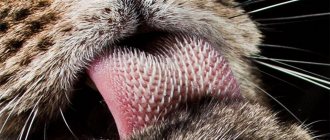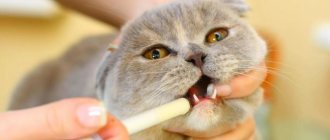Cats are active and very playful animals. Of course, there are extremely lazy individuals, whose most “outstanding” achievement is constant sleep and continuous eating, but still not a single healthy cat will refuse to run properly. Sometimes animals flirt in such a way that they do not behave quite “appropriately”.
And it happens that at this moment short-term convulsions develop: in a cat they often last a couple of seconds, which is why the owners do not have time to understand anything. Meanwhile, any convulsions and seizures, even if they last no more than a couple of seconds, are an extremely bad sign, indicating pathologies that are dangerous to the health and life of the animal.
Description of the disease
Epilepsy is diagnosed in only 0.5-1% of cats. This term refers to a neurological disorder characterized by the sudden onset of seizures. The disease occurs in a chronic form, and the seizures themselves are recorded on a regular basis.
Depending on the severity of the disease, cramps can be observed in individual limbs or throughout the body. They are caused by paroxysmal, or irritating, discharges in the neurons of the brain. In addition to humans and baleen pets, other mammals, including dogs and rodents, also suffer from the disorder.
What are cramps
The first thing all owners of “convulsive” animals need to know is that seizures and other seizures are not a disease in themselves, but they indicate pathological functioning of the brain or the nervous and muscular systems as a whole.
Note that convulsions most often begin in two opposite situations: either the cat is absolutely calm before it, or it is actively moving. It is almost impossible to predict their occurrence.
Causes of epileptic seizures in cats
Treatment methods and prognosis for future life depend on the causes of the pathology. They are divided into 2 large groups: congenital and acquired.
Congenital
From the name it is easy to guess that these reasons contribute to the development of the disease from birth, that is, from the first days of the animal’s birth. These include:
- intrauterine damage to the fetus due to head injuries, hypoxia and infection of the mother;
- inbreeding, or inbreeding;
- poor heredity, that is, the presence of at least one parent with confirmed epilepsy.
The prognosis for such reasons is unfavorable. The disease cannot be treated, so most often the animal is euthanized.
Purchased
Causes from this group affect the animal at a more conscious age. These include:
- brain tumors;
- various pathologies of internal organs (vessels, kidneys, heart, liver);
- prolonged stress;
- hormonal disorders (diabetes mellitus, hypocortisolism);
- traumatic brain injuries;
- bacterial and viral infections;
- poisoning with household chemicals, medicines, plants;
- avitaminosis (namely, a lack of vitamins responsible for the functioning of the nervous system).
In most cases, attacks go away after the underlying cause is eliminated.
At-risk groups
Most often, pathology is diagnosed in representatives of exotic breeds, as well as in males. Regardless of the cause, the first attacks appear no earlier than 5 months after birth.
Video “How to properly wash a cat’s ears”
In this video you can see how to properly clean your pet's ears so as not to cause acne.
Sorry, there are no surveys available at this time.
Was this article helpful?
Thank you for your opinion!
The article was useful. Please share the information with your friends.
Yes
No
X
Please write what is wrong and leave recommendations on the article
Cancel reply
Rate the benefit of the article: Rate the author ( 2 votes, average: 5.00 out of 5)
Discuss the article:
Detailed symptoms of epilepsy in cats
In cats, the pathology manifests itself as epileptic seizures. They are focal and generalized. The first includes convulsive twitching of one part of the body without loss of consciousness, and the second includes convulsions throughout the body, accompanied by fainting.
IMPORTANT!
Recurrence of attacks more than once every 30 days is a dangerous sign that requires mandatory drug treatment.
Three stages of a seizure
All generalized seizures go through 3 stages, differing in different durations and accompanying symptoms. These include:
- Prodromal.
Lasts from 2-3 hours to 2-3 days. Characterized by a vague clinical picture. Most animals experience sleep disturbances, apathy and poor appetite.
- Aura.
Lasts 2-3 minutes. The cat becomes nervous, does not recognize family members and wanders aimlessly around the house, not oriented in space. Sometimes there is profuse salivation. Shortly before the attack, the pet begins to demonstrate hostility, reacting aggressively to stroking and any attempts to be picked up.
- Ictal.
Lasts from 2 seconds to 5 minutes. At this stage, an immediate seizure occurs, which is difficult to miss. The animal suddenly falls on its side and freezes. His breathing stops. The eyes either roll back or stare at one point, followed by dilation of the pupils. Under the influence of convulsions, intense movement of the paws is observed, as when running. Foam appears at the mouth. At this moment the cat can go under himself. His consciousness returns gradually. First, breathing is restored, then the muscles relax, and at the very end the ability to blink and move the pupils returns.
Particular attention should be paid to the postictal stage. It lasts from several hours to several days and occurs immediately after ictal. Despite the absence of pronounced signs, the usual state at this stage still does not occur. The pet appears lost and disoriented. Because of this, he may show aggression, hide, bump into objects, sway when walking, fall or suddenly jump up and rush around the house.
REFERENCE!
The main symptom of the postictal stage is increased appetite.
Status epilepticus
Despite the rather frightening symptoms, epilepsy is not life-threatening in itself. Really serious complications are caused by status epilepticus - a pathological condition characterized by a prolonged attack lasting more than 5 minutes - or a continuous alternation of seizures, between which the cat does not have time to recover.
What symptoms should you be wary of?
Any deviation in the animal’s usual behavior should be alarming.
To prevent seizures from becoming a surprise, you need to pay attention to the accompanying signs:
- uncontrolled urination;
- involuntary defecation;
- dilated pupils;
- flow of saliva or foam from the mouth.
It happens that an animal shows aggression, does not respond to the owner’s voice, and does not allow itself to be touched. This behavior is due to the fact that the cat is frightened by a sudden attack and severe pain.
The danger of epileptic seizures in cats
Status epilepticus leads to serious stress on the brain, provoking the development of other dangerous neurological disorders due to prolonged oxygen deprivation. It also shortens life expectancy, so ignoring it can lead to the death of the animal.
Frequent seizures affect behavior. The cat becomes less active and more irritable. The danger is also noted at the time of immediate convulsions. Due to loss of consciousness, the pet can be seriously injured by falling from a great height or hitting foreign objects.
Convulsions before death
Alas, we are all mortal. Our pets also have their own time limit. Seizures immediately before death are common. Is it possible to somehow understand that this particular seizure is the last in the cat’s life? Most likely (with the exception of hyperacute forms of diseases) this is real.
The seizures themselves in this case are the result of severe (and incompatible with life) changes in the cat’s body. The blood supply and oxygenation of the brain are disrupted, neurons die in the thousands, and normal life activity ceases.
As a rule, a cat does not die “out of the blue.” If he was ill for a long time, suffering greatly, or received a serious head injury in a fall or from a collision with a car, then his death, an extremely sad event, will definitely not be sudden.
Death spasms differ in their duration. From time to time, the appearance of lucid windows is noted, when consciousness returns to the animal for some time. In addition, such convulsions, unlike the “life” varieties, gradually subside, but the cat’s condition noticeably worsens in the intervals between them . Before immediate death, there are relapses of strong, powerful muscle spasms, when the cat's body can literally arch.
Types of pathology
Depending on the cause, pathology is divided into 2 types: congenital and acquired. The first accounts for 30% of all detected cases. It is extremely difficult to diagnose and cannot be treated.
The acquired variety develops under the influence of external and internal environmental factors after the birth of the animal. In most cases, it has a favorable prognosis and recedes soon after the root cause is eliminated.
What is vaginal candidiasis? Causes of the disease
Vaginal candidiasis is an inflammatory disease of the genitourinary tract caused by yeast-like fungi of the genus Candida.
In most cases, the cause of vaginal candidiasis is Candida Albicans. It can reproduce successfully in an oxygen-free environment and grows especially well on tissues that contain large amounts of glycogen, including the mucous membrane of the female genitalia. Recently, doctors are increasingly discovering other pathogens of the Candida genus, but the overall frequency of their occurrence does not exceed 15-30%.
Internal risk factors for the development of vaginal candidiasis include endocrine diseases (diabetes mellitus, obesity, thyroid pathology, etc.), underlying gynecological diseases, disorders of local immunity; to external risk factors - taking antibacterial, glucocorticosteroid, cytostatic drugs, immunosuppressants, radiation therapy; wearing tight clothing, underwear made of synthetic fabrics, regular use of sanitary pads, prolonged use of intrauterine devices, vaginal diaphragms, douching, use of spermicides.
How is the diagnosis carried out?
If you witness an epileptic attack in a cat, be sure to contact your veterinarian. Thanks to timely diagnosis, the complications listed above can be avoided.
Examination of the animal and conversation with the owner
After a visual examination, temperature measurement, palpation of the abdomen and other basic manipulations, the veterinarian will need to collect an anamnesis, that is, all information related to the condition of the sick pet. This point is very important in making a diagnosis, so be sure to describe what happened in every detail, not forgetting to mention the duration of each stage and the events preceding them.
ADVICE!
If you see something unusual, shoot it on camera. Video recording will prevent you from missing an important point during a conversation with a doctor.
Separately describe all your pet’s chronic diseases, as well as those that have long been cured. If you have information about the cat's parents, you should also provide them.
Laboratory research
After collecting an anamnesis, clinical and biochemical tests of urine and blood are taken from the animal, as well as a blood sugar test. Based on their results, the presence of inflammation, intoxication, anemia, diabetes mellitus, as well as various abnormalities in the functioning of the liver and kidneys is determined.
Ultrasound and X-rays are used to check the functionality of major organs and systems, as well as hidden injuries. Brain functionality is checked using an electroencephalogram. If necessary, two more studies are added to the listed studies: CT and MRI.
REFERENCE!
In the absence of obvious causes of the pathology, the pet is diagnosed with “idiopathic epilepsy,” that is, primary.
Prognosis and prevention
To completely cure vaginal candidiasis, it is necessary to both consult a doctor in a timely manner and follow all his recommendations. Antifungal drugs are sold in pharmacies without a prescription, but DIY in this case is not only ineffective, but also dangerous. Only a specialist can correctly select the necessary medications, determine the characteristics of their use, and also monitor the effect of the medications.
It is important to understand that it is much easier to prevent vaginal candidiasis than to treat it. To minimize the risk of developing the disease, you must adhere to the following rules:
- give preference to cotton underwear;
- stop using panty liners;
- use specialized products for genital hygiene;
- do not use douching without a doctor’s prescription;
- monitor the condition of the body, promptly treat pathologies of the genitourinary and digestive systems, endocrine glands;
- avoid casual sex and infection with sexually transmitted diseases;
- do not use antibiotics without a doctor’s prescription and do not change the dose and regimen without permission;
- if long-term antibiotic therapy is necessary, take antifungal agents.
Vaginal candidiasis is an unpleasant disease that can be prevented and, if necessary, quickly cured. The main thing is to consult a doctor in a timely manner and follow all his recommendations.
First aid for a pet
It is important to understand that due to disorientation and loss of consciousness, the animal can be accidentally injured. During a seizure, only the owner who is nearby can help him, so try not to panic and act as calmly as possible.
What should the owner do during an attack?
First, try to catch the stage of the aura. If you succeed, create the most comfortable and safe conditions possible using the following recommendations:
- Draw the curtains, dim the lights, turn off noisy appliances and open the windows to create a quiet environment and bring oxygen into the room.
- Place a sheet, oilcloth or absorbent diaper on the floor and carefully place the cat there so that he is on his side. In this position, there is no risk of tongue sticking, so do not try to stick your fingers or anything else into the mouth.
- Remove all potentially dangerous objects (products with sharp edges, heating surfaces) located nearby.
Never yell at your cat or use brute force on him. Punishments will only make his condition worse.
During an attack, be sure to hold your pet's head so that he does not choke on foam, saliva or vomit. Avoid holding. Pressing down to the floor to artificially suppress convulsions is fraught with dislocation or fracture of the limbs.
After the seizure ends, place water and food near the cat, but do not pick him up. Wait for the pet to fully come to its senses and come to you on its own.
When urgent veterinary help is needed
Urgent veterinary assistance is required for a prolonged attack of more than 5 minutes, a series of seizures without restoration of consciousness, and injury. In such cases, you should make an appointment for an examination on the same day or the next - or call a doctor directly to your home.
Mandatory examination is also necessary for those who are experiencing epilepsy for the first time. Despite this, in this case, in the absence of the listed complications, you can wait a little with an appointment at the veterinary clinic.
What to do if treatment is unsuccessful?
With correctly prescribed therapy, the effect is noticeable from the first days: the animal itches less and the ulcers begin to dry out. If there is no improvement within 5-7 days, you should definitely visit a veterinary clinic.
Even if the veterinarian prescribed the drugs, but there is no result, contact us again. It also happens that an examination by another doctor or in another veterinary clinic helps.
The main thing is not to let things take their course and achieve improvements in the cat’s condition. Otherwise, you will have to treat not only the root cause, but also secondary infections.
Treatment and supportive care
Epilepsy in cats can be treated at home. With the acquired variety, therapy is based on eliminating the root cause. If convulsions are observed frequently, then the animal must be prescribed anticonvulsants. In milder cases, sedatives are sufficient to relax the body.
In addition to taking medications, proper nutrition plays an important role. The easiest way is to switch your pet to ready-made food for epileptic cats. Most of its composition comes from proteins, and a smaller part from grains and other carbohydrates.
Symptoms of vaginal candidiasis
Classic signs of vaginal candidiasis are:
- itching and burning in the vagina and in the external genital area;
- specific discharge resembling cottage cheese;
- pain and burning when urinating;
- discomfort and pain during sexual intercourse.
As a rule, discomfort intensifies in the afternoon, and in some women before menstruation. During a gynecological examination, the doctor detects swelling and redness of the mucous membrane of the genital tract, as well as specific white or yellowish-white cheesy thick vaginal discharge.
With a complicated course of the disease, cracks appear on the skin of the vulva and mucous membranes, posterior commissure and peranal area; with recurrent candidal vulvovaginitis, dryness, atrophy, lichenification in the affected area, and scanty whitish vaginal discharge are expressed.
Make an appointment
Forecasts for future life
With an incurable form of the pathology, the cat remains epileptic for life. In this case, the owner needs to minimize the main provoking factors (loud sounds, flashing bright lights), improve the quality of life of his pet and protect him from injury. If successful, these measures can help achieve lasting remission and reduce the frequency of seizures.
“ Try to avoid stressful situations. If you were planning a move or renovation, then for the sake of your pet’s health you will have to postpone them.
Veterinarian advice
Despite the risks of being outside, the cat needs fresh air, so you should not limit its freedom. Since infections and parasites are transmitted through hands or from other animals, preventative treatment against parasites should be carried out regularly.
Veterinarian advice:
- The animal must be kept clean.
- A good immune system will protect your cat from any infection. The key to health is proper and balanced nutrition.
- To prevent allergies, you should not include smoked and salty foods in your diet. Sweets are also prohibited.
- A change of owner or a sharp change in attitude towards a pet leads to stress and illness. A pet needs to be loved, cared for, and given enough attention.
The cat licks and itches, but there are no fleas
A signal about the development of the disease can be constant licking of fur, scratching and excessive attentiveness to one’s appearance. Often the cat owner thinks that the pet has fleas, but when examining the fur, it is clear that this is not the reason.
Possible causes of itching:
- allergy;
- fungal diseases;
- hormonal diseases;
- hypo- and vitamin deficiencies;
- change of diet.
Be sure to read:
Bald patches in a cat near the ears and above the eyes: reasons, what to do, how to distinguish normality from pathology
The cat licks itself vigorously and goes bald
Sometimes itching occurs for psychogenic reasons. Increased licking and scratching occurs when the animal is stressed. This is often observed when an individual requires mating. Taking sedatives will help calm your pet.
Cat licks after sterilization
Cats always try to lick wounds, sores and other skin lesions. After sterilization, a seam remains, which itches and itch, so the animal scratches and licks it. To prevent bleeding or other serious complications, a surgical collar is placed on the cat.
What to do if your cat is constantly licking
It can be difficult to diagnose why an animal constantly licks itself. First, the cat is checked for fleas, then it is analyzed whether the diet or care products have changed.
With a skin disease, the animal often shakes its head and licks itself until it bleeds. Only a doctor can diagnose the disease, so the pet must be taken to the clinic immediately. Based on the scrapings taken, they will be able to identify mites or fungal spores.
Why you can't stop itching
If you have not yet visited the veterinarian, you should not smear the sores with anything at all - this will distort the results of scrapings and tests, which will complicate the diagnosis. You should not immediately offer your animal antihistamines - firstly, you may not guess the dosage, and secondly, the blood test will be invalid.
Once the veterinarian has prescribed medications and ointments, there is no need to relieve itching - most medications already contain substances that reduce discomfort.
Finally, anti-itch medications in humans can cause allergies in cats, which will only make the problem worse.
Causes
In order to select the correct and high-quality treatment, a specialist at a veterinary emergency center must first determine the reasons for this behavior of the animal’s health condition.
Possible reasons :
- One of the reasons may be epilepsy, which is a complex neurological disease. This diagnosis is made if other causes have already been excluded. First of all, after a specialist from the veterinary center conducted a thorough examination, he took a urine and feces test. He also conducted neurological examinations, an examination of the back of the eye, and monitored the general condition of the pet over time.
- As a result of metabolic disorders, various pathologies of organs, their failures, hypokalemia, hypocalcemia, as well as toxoplasmosis.
- Poor heart function.
- Parasites present in the intestines can also be causes.
- A variety of infectious diseases that are caused by bacteria, viruses and fungi.
- Tumors.
- If the animal is poisoned by chemicals.
A cat twitches in its sleep - is it a spasm or not?
Almost every owner of a kitten or adult cat has at least once observed how their pet twitches in its sleep. This condition cannot be considered convulsions in the literal sense of the word, since twitching does not cause pain in the animal and is not dangerous to its health. In the course of research, scientists were able to find out that cats, like people, have dreams. They may be associated with hunting, exploring unfamiliar places, or communicating with relatives. That is why animals often make characteristic movements with their paws during dreams, as if they were running somewhere.
When a pet sleeps, its eyelids, lips, whiskers and ears may tremble, eyeballs move under closed eyelids, hind limbs twitch, and tail shake. At the same time, it can make various sounds. This is a normal reaction of the body during sleep, which goes away on its own after waking up, without having a negative impact on health.
If a sleeping animal has too intense convulsions, the movements of its paws are chaotic, it arches as if it had been hit, it is recommended to immediately show the cat to a veterinarian.










